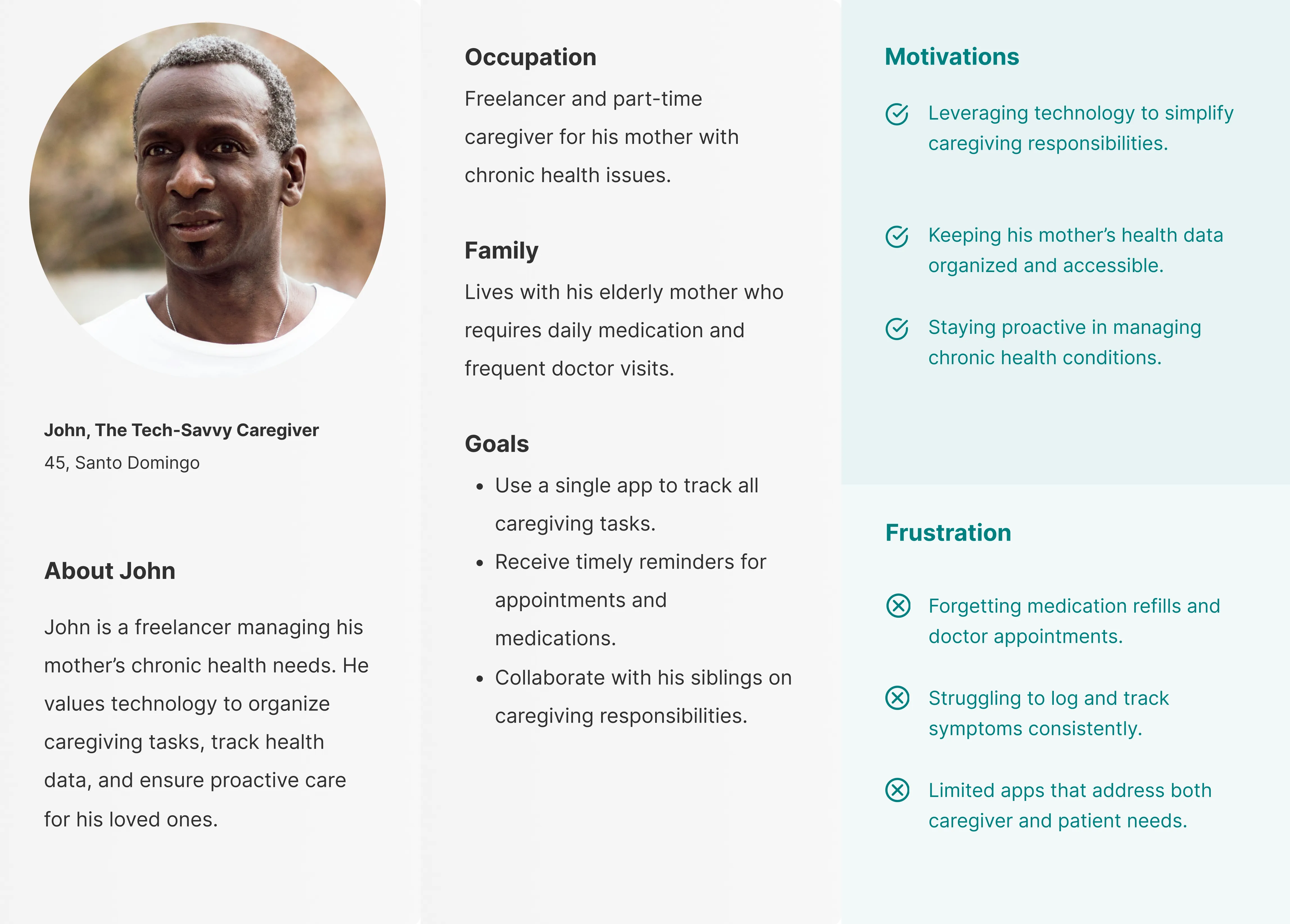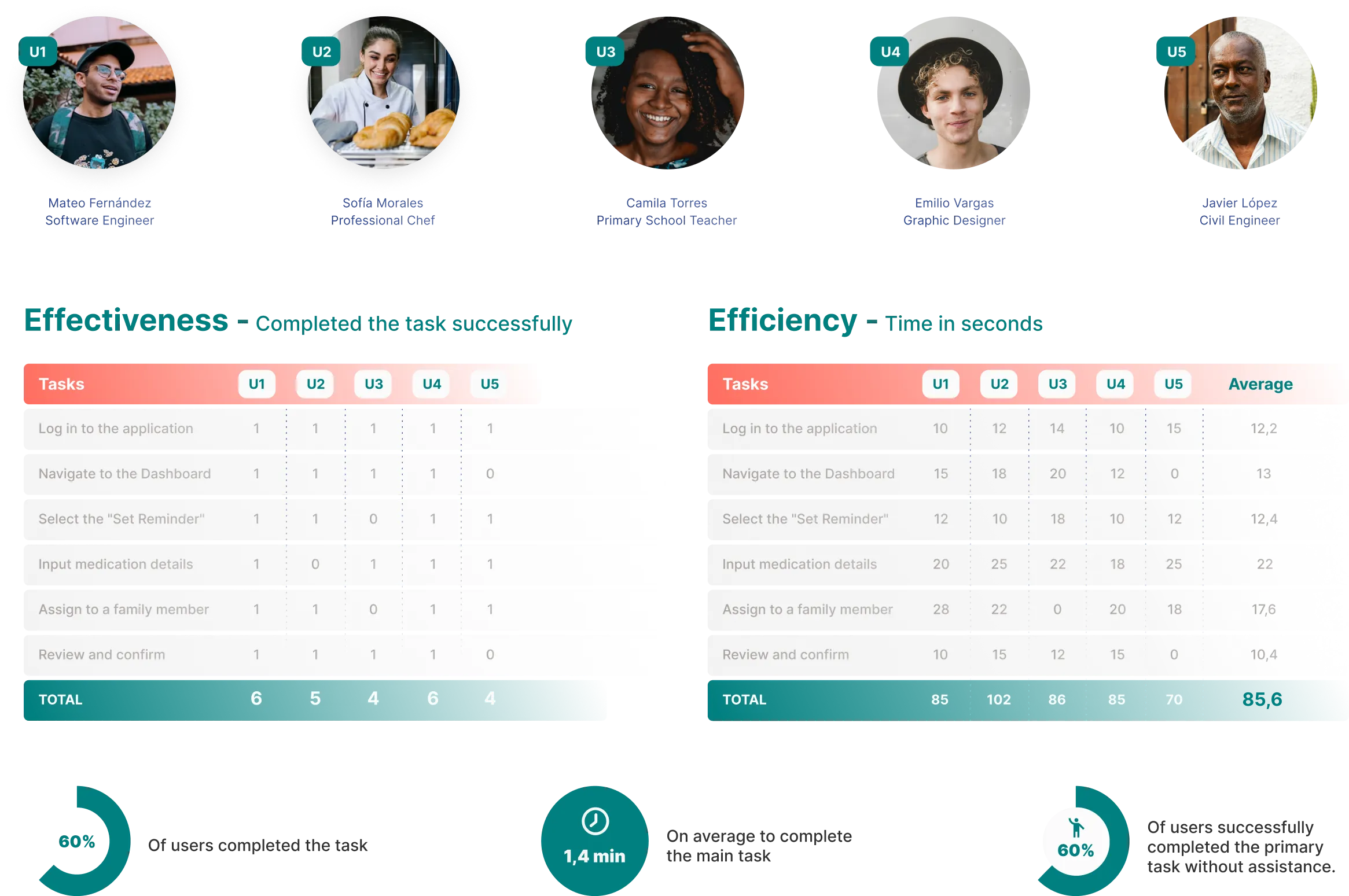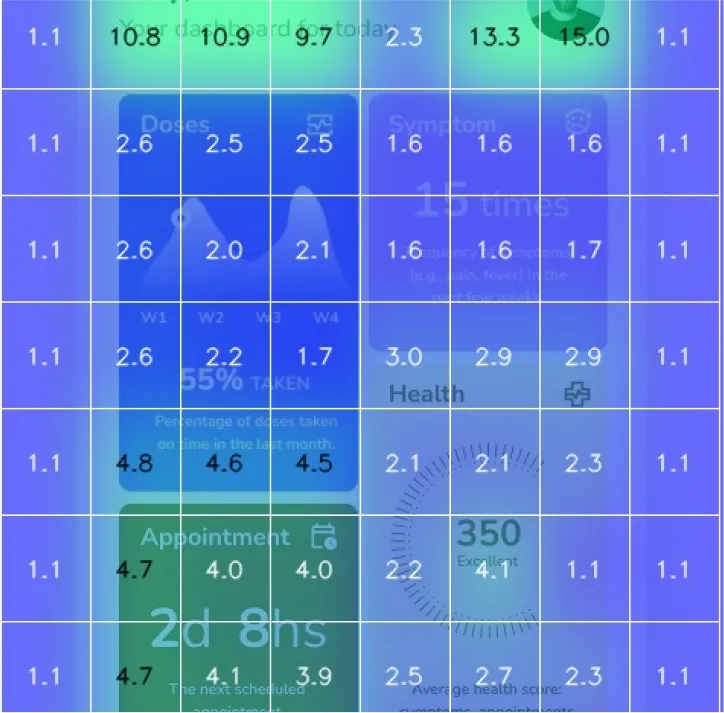

Families struggle to effectively manage their health due to the lack of a simple, centralized, and reliable way to track medications, medical appointments, and health symptoms. This leads to stress, forgetfulness, and a feeling of being overwhelmed when it comes to managing individual and family health needs.
The target audience for the "HealthBuddy" app includes busy families, particularly parents and caregivers, who are responsible for managing the health of multiple family members. This includes individuals who need to track medications, appointments, and symptoms for children, elderly parents, or family members with chronic health conditions. The audience may include working parents, caregivers, and health-conscious individuals looking for an easy-to-use, reliable solution to simplify health management and reduce the stress of keeping track of everyone’s health needs in one place.
Users need a simple solution to track family health, set medication reminders, organize appointments, log symptoms, and monitor progress easily and efficiently.
Users struggle to manage multiple family members' medications and appointments, coordinate health tasks, and track symptoms. They need a simple, centralized system with clear, timely reminders to avoid missing important health tasks.
We used Design Thinking to create this project. First, we learned about fish owners' needs. Then, we defined the main problem: not having tools to monitor fish and water health. We came up with ideas like reminders and water tracking, built a prototype, and tested it with users to make it better.

The design goal of the "HealthBuddy" app is to create a user-friendly and intuitive platform that helps families efficiently manage their health by providing a centralized, reliable system for tracking medications, medical appointments, and health symptoms. The app should reduce stress and confusion by offering easy-to-set reminders, visual progress tracking, and clear notifications. It aims to simplify the process of managing individual and family health needs, allowing users to stay organized, on top of their tasks, and connected with other family members or caregivers, ultimately empowering them to take better care of their loved ones and improve overall health management.
In the process of developing the "HealthBuddy" app, comprehensive research was conducted to better understand the needs, behaviors, and challenges faced by families in managing their health. Through a combination of user interviews and competitive analysis, we gained valuable insights into how users currently track medications, appointments, and symptoms, as well as the pain points that arise from a lack of organization and clarity. These insights have been crucial in shaping the app's features and ensuring it addresses the real-life challenges families encounter, while providing an intuitive and effective solution for managing their health in a way that fits seamlessly into their daily routines.
The user interviews revealed several key insights into the challenges and needs of families when it comes to managing their health. Across various demographics, participants expressed a strong desire for a centralized, easy-to-use platform to track multiple health tasks for family members. Here’s a breakdown of the main findings from the interviews:
Users feel overwhelmed managing multiple health tasks for family members without a unified system, leading to missed activities and stress.
Tracking medications and appointments is difficult; users often forget to take medication or miss appointments due to a lack of reliable reminders.
Users struggle to track and monitor symptoms consistently, hindering their ability to identify health trends or changes over time.
Users need a simple, intuitive app interface that is easy to navigate and doesn’t require a steep learning curve.
Coordinating health tasks between family members is challenging; users want features to delegate tasks and send reminders to others.
Managing family health without proper tools creates stress, anxiety, and a sense of being overwhelmed, leading to emotional fatigue.
The competitive analysis examines existing solutions in the market that address health management, specifically for families. By reviewing similar apps and services, we identified key features, strengths, and weaknesses of competitors. This analysis helped us understand where current offerings fall short, such as in providing centralized, user-friendly platforms for tracking medications, appointments, and symptoms. Insights gained from this comparison are crucial in shaping "HealthBuddy" to not only meet user needs but also offer unique value propositions that distinguish it from other health management tools.

The affinity map provided a structured way to analyze user insights, grouping them into motivations, goals, and pain points. This categorization highlights what drives users, their desired outcomes, and the challenges they face in managing family health, guiding the app’s design and feature priorities.
User personas represent key family caregivers, highlighting their needs, motivations, and challenges in health management.


"HealthBuddy" is a family health management app designed to centralize medications, appointments, and symptom tracking. It simplifies caregiving by providing reminders, health logs, and coordination tools for family members.
Create an intuitive, all-in-one health management app that empowers families to stay organized, reduce stress, and improve overall health outcomes. The app prioritizes simplicity, collaboration, and personalization to address diverse caregiving needs.
The user flow in "HealthBuddy" is designed to be simple and intuitive, ensuring that users can manage their family’s health tasks with ease. From the moment they log in, users can quickly access features like setting medication reminders, scheduling appointments, or logging symptoms. Each task is streamlined, with clear steps and helpful prompts to guide users through the process. By prioritizing ease of use, the app ensures users spend less time navigating and more time focusing on their family’s well-being.
The goal of the user flow is to make managing family health simple and stress-free. It ensures users can quickly complete tasks like setting reminders or tracking symptoms.
The process is straightforward: log in, select a task, and follow clear steps to complete it. The app guides users smoothly to ensure no important steps are missed.

The user flow in "HealthBuddy" is designed to be simple and intuitive, ensuring that users can manage their family’s health tasks with ease. From the moment they log in, users can quickly access features like setting medication reminders, scheduling appointments, or logging symptoms. Each task is streamlined, with clear steps and helpful prompts to guide users through the process. By prioritizing ease of use, the app ensures users spend less time navigating and more time focusing on their family’s well-being.

The app’s information architecture is designed to be intuitive, with clear categories like Dashboard, Medications, Appointments, and Profiles. Each section is easily accessible through a simple navigation bar, ensuring users can quickly find what they need without confusion. The layout supports smooth transitions between tasks and minimizes the number of clicks required to complete key actions.
To design the app, we used a user-centered approach. This involved conducting interviews, analyzing user behaviors, and creating personas to understand the needs and pain points. We also used methods like affinity mapping and competitive analysis to identify opportunities and prioritize features that solve real problems.
The process started with research to gather insights about users and their health management challenges. Next, we defined the problem and brainstormed solutions, leading to detailed concepts and user flows. Finally, these were organized into a clear structure, ready for prototyping and usability testing. Each step focused on simplicity and usability to create a seamless experience.

A hierarchical visual display of the app's content organizes information in a structured manner, making it easy for users to navigate. By prioritizing key elements and grouping related content, the app ensures a seamless user experience. This approach enhances clarity, reduces cognitive load, and helps users find what they need efficiently.

Prototyping is helpful for ideating, testing, and obtaining early feedback. By creating prototypes, we can quickly explore and refine ideas, ensuring they meet user needs and expectations. This process allows us to identify and address potential issues early, improving the overall design and functionality of the final product.

The usability test focused on evaluating how effectively and efficiently users could complete the primary task: setting a medication reminder in the app. Five participants with varying levels of experience in managing health activities were observed as they navigated through the process. This test aimed to identify usability issues, measure task completion rates, and gather insights into user interactions with the app’s key features.

Prototyping is helpful to ideate and iterate faster through ideas. By creating quick prototypes, we can explore different concepts, test them rapidly, and make necessary adjustments. This process speeds up the development cycle, allowing us to refine and improve ideas efficiently.

The testing revealed key pain points and opportunities for improvement while highlighting what worked well.



Improvements to consider

Learnings and general thoughts
The project highlighted the importance of simplicity and efficiency in managing family health. Throughout the process, we learned that users need a centralized system that allows easy tracking of medications, appointments, and symptoms, while offering clear reminders. Key challenges included navigating the app and entering detailed information. However, the overall feedback showed strong interest in the concept. Moving forward, refining the user interface and enhancing features like notifications and task delegation will be crucial to meeting users’ needs and improving their experience.